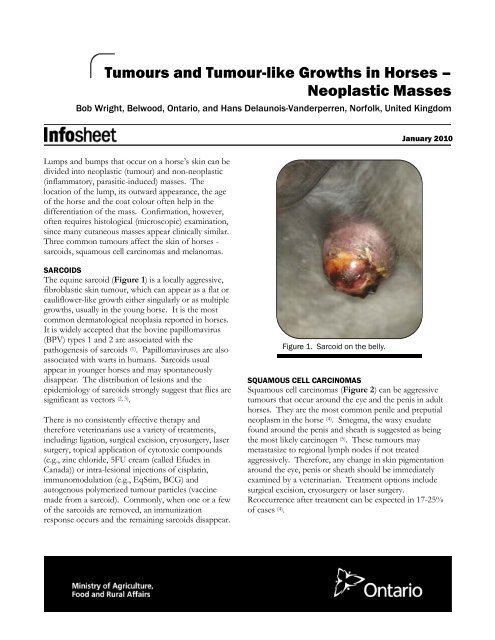Tumours and Tumour-like Growths in Horses - Equine Niagara News
Tumours and Tumour-like Growths in Horses - Equine Niagara News
Tumours and Tumour-like Growths in Horses - Equine Niagara News
You also want an ePaper? Increase the reach of your titles
YUMPU automatically turns print PDFs into web optimized ePapers that Google loves.
<strong><strong>Tumour</strong>s</strong> <strong>and</strong> <strong>Tumour</strong>-<strong>like</strong> <strong>Growths</strong> <strong>in</strong> <strong>Horses</strong> –<br />
Neoplastic Masses<br />
Bob Wright, Belwood, Ontario, <strong>and</strong> Hans Delaunois-V<strong>and</strong>erperren, Norfolk, United K<strong>in</strong>gdom<br />
January 2010<br />
Lumps <strong>and</strong> bumps that occur on a horse’s sk<strong>in</strong> can be<br />
divided <strong>in</strong>to neoplastic (tumour) <strong>and</strong> non-neoplastic<br />
(<strong>in</strong>flammatory, parasitic-<strong>in</strong>duced) masses. The<br />
location of the lump, its outward appearance, the age<br />
of the horse <strong>and</strong> the coat colour often help <strong>in</strong> the<br />
differentiation of the mass. Confirmation, however,<br />
often requires histological (microscopic) exam<strong>in</strong>ation,<br />
s<strong>in</strong>ce many cutaneous masses appear cl<strong>in</strong>ically similar.<br />
Three common tumours affect the sk<strong>in</strong> of horses -<br />
sarcoids, squamous cell carc<strong>in</strong>omas <strong>and</strong> melanomas.<br />
SARCOIDS<br />
The equ<strong>in</strong>e sarcoid (Figure 1) is a locally aggressive,<br />
fibroblastic sk<strong>in</strong> tumour, which can appear as a flat or<br />
cauliflower-<strong>like</strong> growth either s<strong>in</strong>gularly or as multiple<br />
growths, usually <strong>in</strong> the young horse. It is the most<br />
common dermatological neoplasia reported <strong>in</strong> horses.<br />
It is widely accepted that the bov<strong>in</strong>e papillomavirus<br />
(BPV) types 1 <strong>and</strong> 2 are associated with the<br />
pathogenesis of sarcoids (1) . Papillomaviruses are also<br />
associated with warts <strong>in</strong> humans. Sarcoids usual<br />
appear <strong>in</strong> younger horses <strong>and</strong> may spontaneously<br />
disappear. The distribution of lesions <strong>and</strong> the<br />
epidemiology of sarcoids strongly suggest that flies are<br />
significant as vectors (2, 3) .<br />
There is no consistently effective therapy <strong>and</strong><br />
therefore veter<strong>in</strong>arians use a variety of treatments,<br />
<strong>in</strong>clud<strong>in</strong>g: ligation, surgical excision, cryosurgery, laser<br />
surgery, topical application of cytotoxic compounds<br />
(e.g., z<strong>in</strong>c chloride, 5FU cream (called Efudex <strong>in</strong><br />
Canada)) or <strong>in</strong>tra-lesional <strong>in</strong>jections of cisplat<strong>in</strong>,<br />
immunomodulation (e.g., EqStim, BCG) <strong>and</strong><br />
autogenous polymerized tumour particles (vacc<strong>in</strong>e<br />
made from a sarcoid). Commonly, when one or a few<br />
of the sarcoids are removed, an immunization<br />
response occurs <strong>and</strong> the rema<strong>in</strong><strong>in</strong>g sarcoids disappear.<br />
Figure 1. Sarcoid on the belly.<br />
SQUAMOUS CELL CARCINOMAS<br />
Squamous cell carc<strong>in</strong>omas (Figure 2) can be aggressive<br />
tumours that occur around the eye <strong>and</strong> the penis <strong>in</strong> adult<br />
horses. They are the most common penile <strong>and</strong> preputial<br />
neoplasm <strong>in</strong> the horse (4) . Smegma, the waxy exudate<br />
found around the penis <strong>and</strong> sheath is suggested as be<strong>in</strong>g<br />
the most <strong>like</strong>ly carc<strong>in</strong>ogen (5) . These tumours may<br />
metastasize to regional lymph nodes if not treated<br />
aggressively. Therefore, any change <strong>in</strong> sk<strong>in</strong> pigmentation<br />
around the eye, penis or sheath should be immediately<br />
exam<strong>in</strong>ed by a veter<strong>in</strong>arian. Treatment options <strong>in</strong>clude<br />
surgical excision, cryosurgery or laser surgery.<br />
Reoccurrence after treatment can be expected <strong>in</strong> 17-25%<br />
of cases (4) .
Figure 2. Squamous cell carc<strong>in</strong>oma on<br />
the penis of a geld<strong>in</strong>g.<br />
Figure 3. Melanoma of the tail <strong>and</strong><br />
per<strong>in</strong>eal area of a mare.<br />
MELANOMAS<br />
For the Percheron breed <strong>and</strong> horses that are white or<br />
dappled <strong>in</strong> colour, the most common neoplasia is the<br />
melanoma or melanocytic tumour (Figure 3). It is not a<br />
case of whether a grey horse will develop a melanoma(s)<br />
but, rather, when <strong>and</strong> where will it develop. Melanomas<br />
are not a s<strong>in</strong>gle entity but a complexity of equ<strong>in</strong>e<br />
proliferative cutaneous melanocytic lesions with at least<br />
three different forms, <strong>in</strong>clud<strong>in</strong>g: melanocytic nevi<br />
(melanocytoma), dermal melanomata (if there are multiple,<br />
confluent dermal melanomas, this is referred to as dermal<br />
melanomatosis) <strong>and</strong> anaplastic malignant melanomata (1, 6) .<br />
These tumours commonly appear under the tail, per<strong>in</strong>eum<br />
<strong>and</strong> external genitalia, as well as the parotid area (beh<strong>in</strong>d<br />
the jaw). They are usually slow-grow<strong>in</strong>g, locally-<strong>in</strong>vasive<br />
tumours with the potential to metastasize <strong>in</strong>ternally.<br />
Surgical excision, cryosurgery or laser surgery can be used<br />
to remove those melanomas that are bothersome to the<br />
horse <strong>and</strong> owner. Cimetid<strong>in</strong>e, a histam<strong>in</strong>e H2-receptor<br />
antagonist that is used <strong>in</strong> humans to <strong>in</strong>hibit the production<br />
of acid <strong>in</strong> the stomach, has been used to slow the growth<br />
of melanomas with mixed results.<br />
REFERENCES<br />
1. Schöniger S, Summers BA. Equ<strong>in</strong>e sk<strong>in</strong><br />
tumours <strong>in</strong> 20 horses resembl<strong>in</strong>g three<br />
variants of human melanocytic naevi. Vet<br />
Dermatol 2009; 20(3):165-173. Epub 2009<br />
Apr 3.<br />
2. Knottenbelt D. Sk<strong>in</strong> neoplasia: sarcoid. In:<br />
9 th Congresso Nazionale Multisala SIVE, Pisa,<br />
2003.<br />
3. Yu AA (2006): Sarcoids. Proc American<br />
Association of Equ<strong>in</strong>e Practitioners 2006;<br />
52:478-483.<br />
4. van den Top JG, de Heer N, Kle<strong>in</strong> WR,<br />
Ens<strong>in</strong>k JM. Penile <strong>and</strong> preputial squamous cell<br />
carc<strong>in</strong>oma <strong>in</strong> the horse: a retrospective study<br />
of treatment of 77 affected horses. Equ<strong>in</strong>e<br />
Vet J 2008; 40(6):533-537.<br />
5. Lopate C, LeBlanc M, Knottenbelt D.<br />
Neoplasms of the reproductive organs. In:<br />
Chapter 4, Equ<strong>in</strong>e stud farm medic<strong>in</strong>e <strong>and</strong><br />
surgery, The Stallion. London:Saunders,<br />
Elsevier Science Ltd., 2003:100-104.<br />
6. Valent<strong>in</strong>e BA. Equ<strong>in</strong>e melanocytic tumours: A<br />
retrospective study of 53 horses (1988-1991).<br />
J Vet Internal Medic<strong>in</strong>e 1995; 9(5):291-297.<br />
2
Dr. Bob Wright is retired from the position of Lead<br />
Veter<strong>in</strong>arian, Equ<strong>in</strong>e <strong>and</strong> Alternate Species, Ontario<br />
M<strong>in</strong>istry of Agriculture, Food <strong>and</strong> Rural Affairs, <strong>and</strong> now<br />
provides consultation on the horse <strong>in</strong>dustry from his<br />
home <strong>in</strong> Belwood, Ontario. r.wright@everus.ca<br />
Dr. Hans Delaunois-V<strong>and</strong>erperren, DVM,<br />
CertEM(StudMed), GespPD, MRCVS, is <strong>in</strong> equ<strong>in</strong>e<br />
practice <strong>in</strong> Norfolk, United K<strong>in</strong>gdom. He is currently<br />
work<strong>in</strong>g on his Masters degree at the University of<br />
Ed<strong>in</strong>burgh. hans.delaunois@googlemail.com<br />
Permission is granted to use <strong>and</strong> reproduce<br />
this article <strong>in</strong> its entirety provided credit is<br />
given as follows:<br />
Dr. Bob Wright, Belwood, Ontario, Canada,<br />
<strong>and</strong> Dr. Hans Delaunois-V<strong>and</strong>erperren,<br />
Norfolk, United K<strong>in</strong>gdom.<br />
Material may not be changed without the<br />
permission of the author. Contact Dr. Bob<br />
Wright r.wright@everus.ca<br />
Agricultural Information Contact Centre:<br />
1-877-424-1300<br />
E-mail: ag.<strong>in</strong>fo.omafra@ontario.ca<br />
Northern Ontario Regional Office:<br />
1-800-461-6132<br />
www.ontario.ca/omafra



